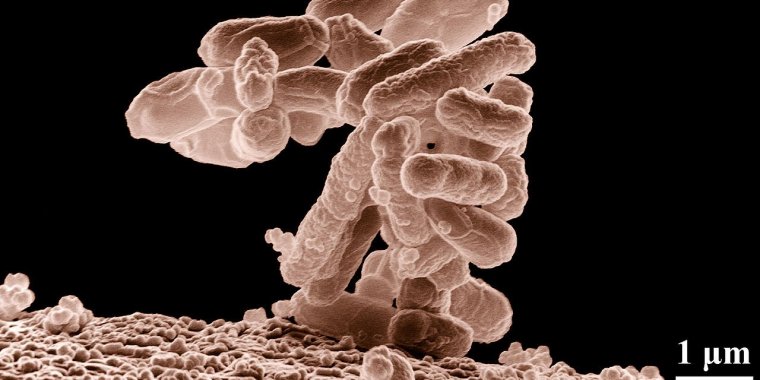| News / Science News |
Earth-based life can survive in hydrogen-rich atmospheres
A study conducted by Massachusetts Institute of Technology professor Dr Sara Seager and other researchers, show single-celled organisms like Escherichia coli (E. coli) and yeast can thrive in both 100% hydrogen gas and helium atmospheres.

A cluster of E. coli bacteria. Image: Eric Erbe
Life has not been observed in any habitat other than Earth, which has an oxygen-rich environment. While Earth's atmosphere is dominated by nitrogen gas, oxygen is essential for advanced living organisms.
Some species of microorganisms do not require oxygen for metabolism, called anærobic organisms, such as methanogens which rely on carbon-dioxide while releasing methane.
Researchers used Escherichia coli strain K-12 and Saccharomyces cerevisiæ strain S288C for this experiment. The two microorganisms were kept in four different environments: one being 100% air, and the other three being anærobic environments: 100% H2, 100% He, and 80%-20% N2-CO2.
The environments were kept in at 28° Celsius. The researchers made sure the anaerobic experiment environments were anoxic, and had installed oxygen sensors to report fluctuation in the oxygen level.
They monitored growth of E. coli using optical density measurement, and they used a hæmocytometer for yeast.
The study reported the organisms were reproducing normally in both 100% H2 and 100% He environment.
However, the sigmoid-shaped growth curve was not on par with 100% air. E. coli and yeast switch from ærobic respiration, which uses oxygen, to anærobic respiration and fermentation. Both processes are less efficient and do not produce as much energy as ærobic respiration.
E. coli in an 80%-20% N2-CO2 environment had slower growth rate as CO2 dissolves and makes the liquid medium acidic.
Such reduction in growth rate was not observed for yeast cultures, which can thrive in acidic environments.
However, yeast's growth rate in 100% air was far greater than in the other three media. The likely reason for this significant difference was lack of oxygen for non-respiratory purposes, the research reported.
Oxygen is essential for synthesis of biochemicals such as heme and sterols, which are important for yeast. In atmospheres lacking oxygen to produce these chemicals, yeast fungi have stunted growth rate.
With this discovery, Dr Seager said scientists can now observe even more planets to study for habitable life. "There's a diversity of habitable worlds out there, and we have confirmed that Earth-based life can survive in hydrogen-rich atmospheres. We should definitely add those kinds of planets to the menu of options when thinking of life on other worlds, and actually trying to find it", Professor Seager said.
A rocky planet with expanded hydrogen-rich atmosphere should be easy to detect using the emerging technologies. Hydrogen and helium gas have very low density.
Dr Seager said, "It's kind of hard to get your head around, but that light gas just makes the atmosphere more expansive [...] And for telescopes, the bigger the atmosphere is compared to the backdrop of a planet's star, the easier it is to detect."
The research paper noted rocky planets which have radius below 1.7 times Earth's radius (Earth's radius is roughly 6360 km) can support a hydrogen-rich atmosphere, if water were to react with Iron.
The research paper reported E. coli releases a number of gases when it lives in hydrogen-based atmosphere including ammonia, methanethiol, dimethylsulfide, carbonyl sulfide, carbonyl disulfide and nitrous oxide.
These gases can serve as biosignature gases which can help astronomers detect and study potential life on exoplanets. (Wikinews)
YOU MAY ALSO LIKE





